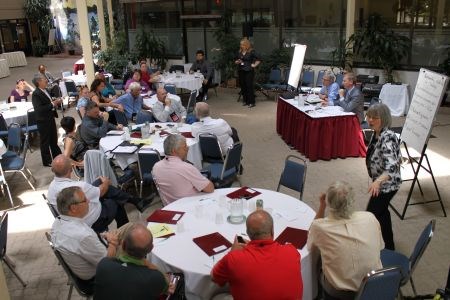Attending the Think North II summit and working with delegates from across Northern Ontario marks the halfway point to a successful Growth Plan for Northern Ontario, said Irish guest speaker John Gallagher.
But for most listening to his presentation, it certainly didn't feel that way.
Nearly 500 people representing communities and townships from across Northern Ontario attended the four-day summit hosted by the Ministry of Northern Development, Mines and Forestry (MNDMF) in Thunder Bay and Sudbury.
The event attracted guest speakers from around the world who shared their stories of economic development success with those in attendance, and offered ideas and advice as to how Northern Ontario can improve theirs.
But the more delegates listened, the more some got upset.
Many expressed frustration with the overall summit, strictly because they were prepared to attend the event and get directly to work, not listen to presentations and talks regarding yet more planning.
A councillor for the Township of Conmee, Bob MacMaster, expressed his frustration with the entire process, and said when he was driving to the summit in Thunder Bay, he said to himself, “great, more planning and more discussions.”
Laurentian University economics professor David Robinson said representatives from around the North with whom he spoke all felt that the panellists were saying what Northerners have been saying for a decade, that more research isn't what is needed. They wanted to see action.
But Michael Gravelle, Minister for Northern Development, Mines and Forestry, said they were on the same page.
“There's no doubt that during this conference, our goal is to work together to develop an action plan, and I want to stress that word, action,” said Gravelle. “This is an opportunity for us to develop a new approach to economic development planning in Northern Ontario and we're excited about the opportunities that come with that.”
He said the growth plan is a document created by Northerners for Northerners, and it must remain that way for it to be successful.
The ministry has also created a Northern Advisory Committee (NAC) consisting of individuals from across the North with different backgrounds and expertise to oversee the work of the two pilot groups and make recommendations to the government and the pilot groups.
Jane Blackwell is co-chair of NAC and said she knows that people are growing impatient but stressed that good things are just around the corner.
“We've heard many times that some of you came here today prepared to roll up your sleeves and get going,” she said. “You expected to leave today with deadlines and so on; that's passion and that's the passion that we want you to hold on to and continue to have, the passion to move ahead.”
Reaction from the business community was mixed.
“I think it sets up a good foundation for the future,” said Debbi Nicholson, president of the Greater Sudbury Chamber of Commerce. “We look forward to developing those further and creating excellent economic development for the North.”
But other small business owners felt they hadn't been adequately consulted and there was little representation from the private sector at the summit.
Yves Gauthier, president of Gencor, an Earlton agri-food business, said there has been little interaction between the ministry and the private sector, even though small business is integral to creating economic growth in the North.
“I haven't heard anyone sit down and ask them, 'What do you need?'” he said. “You never hear of anybody trying to help the private sector, and that's one thing I'd like to see.”
In June, Tom Dodds, chief executive officer for the Sault Ste. Marie Economic Development Corporation, circulated a terse treatise to communities across the North indicating the Sault felt it had been left out of the consultation process, and that the focus of the entire survey has been directed to Sudbury and Thunder Bay.
“An overarching or comprehensive approach to or strategy for the implementation plan of the Growth Plan does not appear to exist,” he wrote in the letter. “If one does, it has not been shared with Northerners or the region's key stakeholders.”
Kenora Mayor Dave Canfield described it as a great framework for growth, “but it's more like the motherhood and apple pie. I think the real meat and potatoes of it is the stuff we're putting into it and discussing.”
“This is really just a framework as opposed to a plan.”
While excessive planning and lack of action was a centrepiece of the summit, the dearth of involvement from First Nations representatives was palpable.
Several First Nations representatives left early during the first day of the Thunder Bay conference, due to what they perceived as a lack of trust between them and the ministry.
While one Aboriginal delegate said he didn't speak for all First Nation representatives who attended the conference, he said First Nations have to validate and verify the government's policies before they will participate.
“We need to have a plan, because we always slip through the policy gaps from the government,” he said. “There are potential opportunities, but the trust just isn't there.”
Also at the conference, it was announced that the Northern Ontario Heritage Fund Corporation (NOHFC) is providing $5 million for the Northern Policy Institute.
It will be a not-for-profit, independent entity with more details set to be released this summer.
The NOHFC is also providing $1.2 million for the Multi-Modal Transportation Strategy, with the Ministry of Transportation adding $1 million.
It will begin with a survey to determine more information about the highways to assess what the systems needs.
Delegates left the summit with no clear indication of what steps will be taken next. Information gathered over the four days will be presented to NAC and the pilot teams in July, Blackwell urged patience in the interim.




